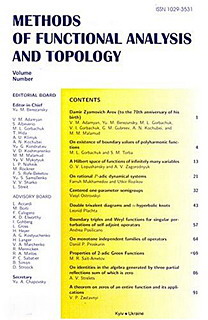Vol. 24 (2018), no. 1
Parametrization of scale-invariant self-adjoint extensions of scale-invariant symmetric operators
Miron B. Bekker, Martin J. Bohner, Alexander P. Ugolʹnikov, Hristo Voulov
MFAT 24 (2018), no. 1, 1-15
1-15
On a Hilbert space $\frak H$, we consider a symmetric scale-invariant operator with equal defect numbers. It is assumed that the operator has at least one scale-invariant self-adjoint extension in $ \frak H$. We prove that there is a one-to-one correspondence between (generalized) resolvents of scale-invariant extensions and solutions of some functional equation. Two examples of Dirac-type operators are considered.
Lie derivations on the algebras of locally measurable operators
Vladimir Chilin, Ilkhom Juraev
MFAT 24 (2018), no. 1, 16-26
16-26
We prove that every Lie derivation on a solid $\ast$-subalgebra in an algebra of locally measurable operators is equal to a sum of an associative derivation and a center-valued trace.
On similarity of unbounded perturbations of selfadjoint operators
MFAT 24 (2018), no. 1, 27-33
27-33
We consider a linear unbounded operator $A$ in a separable Hilbert space with the following property: there is an invertible selfadjoint operator $S$ with a discrete spectrum such that $\|(A-S)S^{-\nu}\|<\infty$ for a $\nu\in [0,1]$. Besides, all eigenvalues of $S$ are assumed to be different. Under certain assumptions it is shown that $A$ is similar to a normal operator and a sharp bound for the condition number is suggested. Applications of that bound to spectrum perturbations and operator functions are also discussed. As an illustrative example we consider a non-selfadjoint differential operator.
A probabilistic proof of the Vitali Covering Lemma
E. Gwaltney, P. Hagelstein, D. Herden
MFAT 24 (2018), no. 1, 34-40
34-40
The classical Vitali Covering Lemma on $\mathbb{R}$ states that there exists a constant $c > 0$ such that, given a finite collection of intervals $\{I_j\}$ in $\mathbb{R}$, there exists a disjoint subcollection $\{\tilde{I}_j\} \subseteq \{I_j\}$ such that $|\cup \tilde{I}_j| \geq c |\cup I_j|$. We provide a new proof of this covering lemma using probabilistic techniques and Padovan numbers.
Adjunction formula, Poincaré residue and holomorphic differentials on Riemann surfaces
MFAT 24 (2018), no. 1, 41-52
41-52
There is still a big gap between knowing that a Riemann surface of genus $g$ has $g$ holomorphic differential forms and being able to find them explicitly. The aim of this paper is to show how to construct holomorphic differential forms on compact Riemann surfaces. As known, the dimension of the space $H^1(\mathcal{D}, \mathbb{C})$ of holomorphic differentials of a compact Riemann surface $\mathcal{D}$ is equal to its genus, $\dim H^1(\mathcal{D}, \mathbb{C})=g(\mathcal{D})=g$. When the Riemann surface is concretely described, we show that one can usually present a basis of holomorphic differentials explicitly. We apply the method to the case of relatively complicated Riemann surfaces.
On the mean ergodicity of weak solutions of an abstract evolution equation
MFAT 24 (2018), no. 1, 53-70
53-70
Found are conditions of rather general nature sufficient for the existence of the limit at infinity of the Cesàro means $$ \frac{1}{t} \int_0^ty(s)\,ds $$ for every bounded weak solution $y(\cdot)$ of the abstract evolution equation $$ y'(t)=Ay(t),\ t\ge 0, $$ with a closed linear operator $A$ in a Banach space $X$.
Categories of unbounded operators
MFAT 24 (2018), no. 1, 71-81
71-81
In this article we introduce the concept of an $LK^\ast$-algebroid, which is defined axiomatically. The main example of an $LK^\ast$-algebroid is the category of all subspaces of a Hilbert space and closed (not necessarily bounded) linear operators. We prove that for any $LK^\ast$-algebroid there is a faithful functor that respects its structure and maps it into this main example.
Strong convergence in topological spaces
Mehmet Ünver, Şeyhmus Yardimci
MFAT 24 (2018), no. 1, 82-90
82-90
Study of summability theory in an arbitrary topological space is not always an easy issue as many of the convergence methods need linear structure in the space. The concept of statistical convergence is one of the exceptional concepts of summability theory that can be considered in a topological space. There is a strong relationship between this convergence method and strong convergence which is another interesting concept of summability theory. However, dependence of the strong convergence to the metric, studying similar relationship directly in arbitrary Hausdorff spaces is not possible. In this paper we introduce a convergence method which extends the notion of strong convergence to topological spaces. This new definition not only helps us to investigate a similar relationship in a topological space but also leads to study a new type of convergence in topological spaces. We also give a characterization of statistical convergence.


